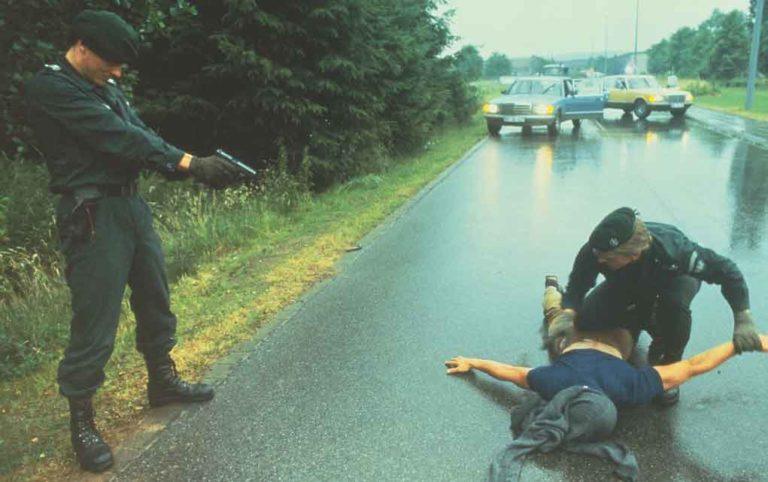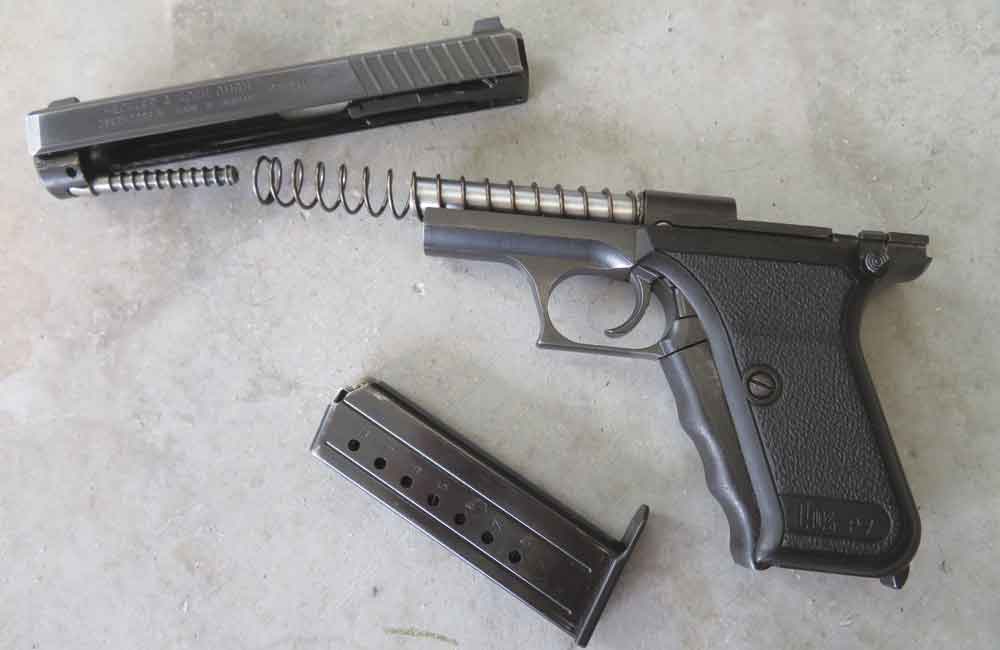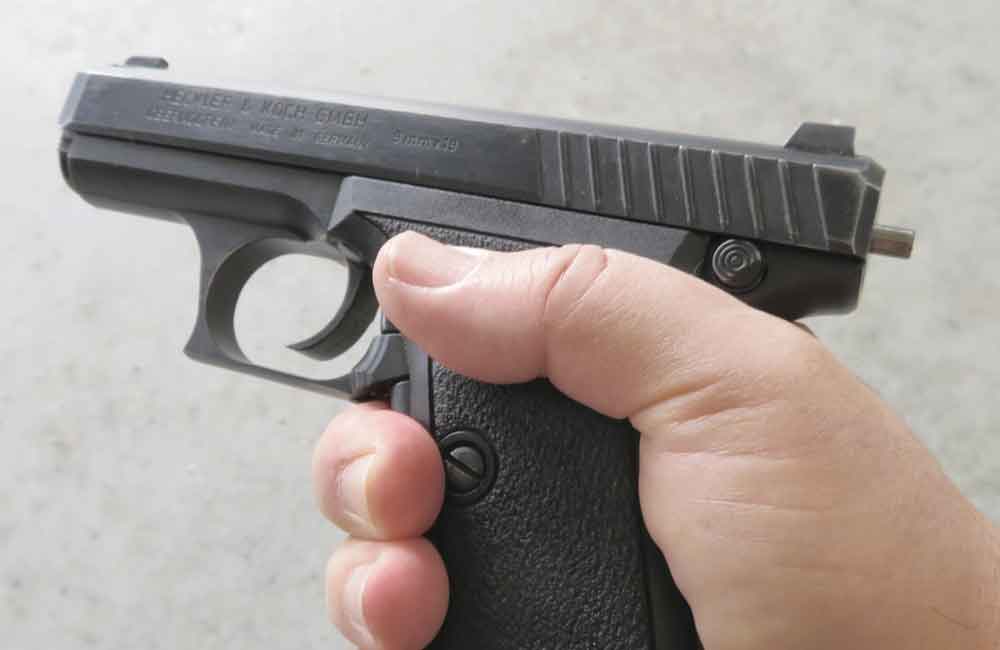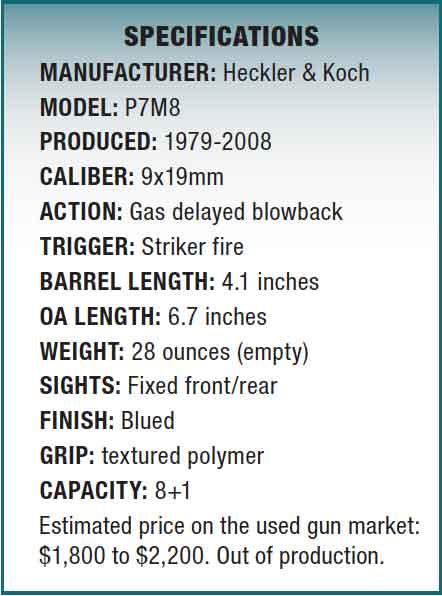
Heckler & Koch's P7 series of pistols are truly unique, not only due to their delayed-blowback system, but also due to their peculiar squeeze-grip cocking mechanism.
- The Heckler & Koch P7 series was touted as the company's finest, most reliable and most expensive pistol line in its run from 1979 to 2008.
- What set the P7s apart from contemporaries of the time and today is their unique squeeze-cocker grip, which were the pistols' only safety.
- The P7 design is also intriguing due to its lack of slide rails; the slide stays in place through the barrel, which makes it truly easy to manipulate.
- The P7 is a hefty pistol, given its metal frame; this extra weight pays off in the accuracy department, helping it keep on target.
The Heckler & Koch P7 is iconic not just because it employs a gas delayed-blowback system but for other features designed into the gun. From 1979 thru 2008, the P7 series was positioned by H&K as the finest, most reliable and most expensive — yes they actually used that tag line in advertisements — pistol available. There was nothing like it on the market. At the time, the P7 was probably the most expensive pistol on the market. Other features in the pistol actually over shadowed the gas delayed-blowback system like the squeeze-cocking grip, striker-fire single-action trigger, and a number of other features that made the P7 stand out from the other 9mm pistols of that time.
The P7 was designed by H&K to replace the 7.65mm caliber pistols used by West German police in the early 1970s. Part of the criteria for the new pistol required that it be chambered in 9mm, weight was not to exceed 35 ounces, and the pistol’s size could not be more than 180mm × 130mm × 34 mm — that’s 7.08 in. x 5.11 in. x 1.33 in. for the metric challenged. The pistol also needed to be fully ambidextrous, safe to carry with a loaded chamber, have the ability to be quickly drawn and fired instantly, and have a service life of at least 10,000 rounds.

The H&K P7, along with submissions from SIG and Walther, won contracts. The P7 was officially adopted as the PSP, and it wasn’t long before other law enforcement agencies in Germany embraced the pistol as well as special forces in the German military. Greece and Mexico produced licensed variants of the pistol while other countries around the globe adopted the P7. Stateside, the P7 was adopted by the New Jersey State Police in 1981. The U.S. Park Police as a well as a few other LE agencies adopted the pistol. Back in the 1980s, the H&K P7 was a high-tech, cutting-edge pistol design.
What really sets the P7 series apart from contemporaries of the time and today is the squeeze-cocker grip. The front grip strap is actually a cocking lever. Grip the pistol and squeeze like you would normally grip a pistol. It takes about 13 to 15 pounds to squeeze the cocking lever and about one pound to hold it. Think of it like a compound bow; initially, it takes more effort, then less to hold it. Once cocked, a pin protrudes from the rear of the slide indicating to the user the pistol is cocked and ready to be fired. The cocking lever actually moves the striker into battery so the pistol will fire when the trigger is pressed. A relatively crisp single-action trigger press of about five pounds fires the pistol.
This squeeze-cocker feature allows the pistol to be safely carried with a round in the chamber, and it is the only safety device on the pistol. In the event the firing pin fails to dent the primer of the cartridge and the round does not go off, the cocking lever can be released and squeezed again to fire the pistol. The cocking lever also makes the pistol harder for those with weak hand muscles, like children, to fire the pistol.

The squeeze-cocking lever is a bit odd for an experienced pistol shooter, but I found my ramp up time was quick. The P7 has natural pointing ability and excellent balance. Most of the weight is in the butt, and the bore axis is low. The pistol is also small. There is not a lot of pistol forward of the trigger guard. The P7 and the Walther CCP have the barrel fixed to the receiver so the barrel does not move during firing. This design trait makes the pistol inherently more accurate than a locked breech and tilting barrel mechanism. Not that the P7 or the CCP are target pistols by any means.
Missing in these designs are slide rails. The slide stays on the receiver because of the barrel. The slide is easy to manipulate. Using the pinch-and-pull method or hand-over-the-slide method, the slide is effortless to rack, unlike some compact locked breech designs that require strength to manipulate the slide. Other design features of the P7 include a fluted chamber similar to an H&K G3 or PTR 91 rifle. The flutes in the chamber allow the pressure from a fired round to eject the empty brass cartridge. The P7 does have an extractor, which helps makes the ejection run more smoothly, but in the case that the extractor breaks, you are not out of the gunfight. The P7 will still run. Empties will still eject. What was also new at the time and relatively common today is the P7’s polygonal-rifled barrel.
The P7M8 I used for testing had a European-style magazine release in the butt. Later variants of the P7 used a thumb magazine release. The sights are large and easy to align.

Compared to other compact locked breech pistols, there was a difference in the cycling. I ran the P7 with three different bullet weights and different bullet types: Hornady American Gunner with 115-grain XP jacketed hollow point bullets, Aguila 124-grain FMJs and Liberty Ammunition Civil Defense 50-grain hollow point bullets. Muzzle velocities varied among the cartridges, with the Liberty Ammunition screaming out the barrel at 1,943 fps. The Hornady and Aguila were what you would expect, about 1,080 and 1,010 fps, respectively. I had a compact locked breech pistol along firing the same ammunition, and there was a difference in felt recoil. The P7 was softer. There were no issues with any of the ammo, and the P7 had a preference for the hot 50-grain Liberty ammo. My best five-shot group at 25 yards was 1.08 inches.
The P7 is not the lightest of compact pistols since it uses a metal frame, but that extra weight made the P7 a sweet-shooting pistol. On average, five-shot groups ranged from 1.5 to 1.7 inches at 25 yards. This old school pistol still has game.

Field stripping the P7 is simple after removing the magazine. Press the takedown button, retract the slide and pull up. The slide assembly can then be slid off the barrel. Attached to the slide is the piston, which pivots on a pin. When reassembling, the piston needs to be aligned with the cylinder in the receiver. The process is easy, albeit different from the takedown procedure of a locked breech pistol. The piston and cylinder need special attention when cleaning to ensure carbon and burnt propellant debris is removed. This is more complicated than the process for a locked breech pistol for sure.
The P7 series spawned variants. The P7M8 is a 9mm single-stack with 8+1 capacity, and the P7M13 comes with a 13+1 round capacity. Others included a P7M10 in .40 S&W and a few others. The P7M8 and P7M13 need to be on every pistol shooter’s bucket list. If a pal has one, ask to shoot it. It will be a lot less expensive than purchasing one. If you do buy one, know that it will increase in value and that you will be eating Ramen noodles for a month.
Editor's Note: This article is an excerpt from Gun Digest 2018.

Next Step: Get your FREE Printable Target Pack
Enhance your shooting precision with our 62 MOA Targets, perfect for rifles and handguns. Crafted in collaboration with Storm Tactical for accuracy and versatility.
Subscribe to the Gun Digest email newsletter and get your downloadable target pack sent straight to your inbox. Stay updated with the latest firearms info in the industry.

![Best Concealed Carry Guns In 2025 [Field Tested] Wilson Combat EDC X9S 1](https://gundigest.com/wp-content/uploads/Wilson-Combat-EDC-X9S-1-324x160.jpg)


![Best 9mm Carbine: Affordable PCCs [Tested] Ruger Carbine Shooting](https://gundigest.com/wp-content/uploads/Ruger-Carbine-Shooting-100x70.jpg)
![Best AR-15: Top Options Available Today [Field Tested] Harrington and Richardson PSA XM177E2 feature](https://gundigest.com/wp-content/uploads/Harrington-and-Richardson-PSA-XM177E2-feature-100x70.jpg)

Some facts about P7 pistols…
– The barrel only guides the slide at the front section… There are guide rails at rear…
– Movable sear bar slams against the receiver at every time the cocking lever released… As causing breakage…
– Gas system is not for delaying the slide initial opening at instant of the maximum gas pressure existing inside the barrel… It is simply gas ram buffer to soften the recoil impact…
– The striker stops against to the striker safety block when dry fired…
– Striker safety block retains its place by means of its own spring which prone to leave its location through heavy shots which turning the pistol into a paper weight…